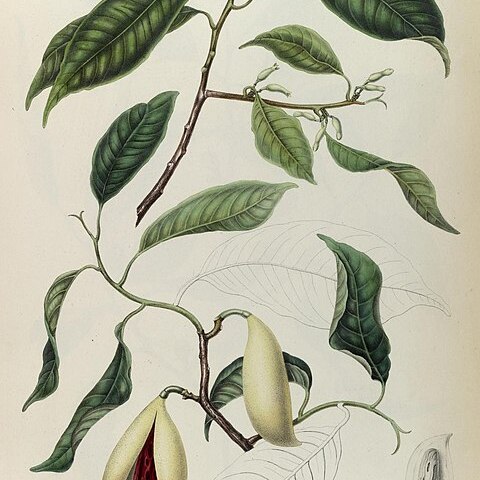Tree 3-24 m. Twigs subterete or ± angular, yellowish brown, (0.5—)1—1.5 mm diameter, early glabrescent, hairs less than 0.1 mm; older twigs cracking and flaking; lenticels small, dense on younger twigs, indistinct or absent on the older twigs. Leaves membranous or thinly coriaceous, (elliptic-)oblong, 5—14(—16) by 1.5—5.5(—7.5) cm, base attenuate or rarely ± rounded, apex acute-acuminate, with ± blunt or acute tip; upper surface olivaceous, lower surface pale brown, glabrous; not papillose; dots absent; midrib raised above, lateral nerves 8-13 per side, at 60-70° to the midrib, flat or sunken above, far apart, lines of interarching and venation indistinct; petiole 10-18 by 0.8-1.5 mm; leaf bud conspicuously slender, 5-12 by 0.5-1 mm, hairs less than 0.1 mm. Inflorescences between the older leaves or below, of the Knema-type: a simple sessile scar-covered brachyblast up to 4 mm long, glabrescent; bracts minute; in male: 1-3 (-4)-flowered, buds of slightly variable sizes; in female minute, sessile, 1-(or 2-)flowered; flowers glabrous (or with few scattered appressed hairs less than 0.1 mm). Male flowers: pedicel 8-11.5 mm, bracteole ovate-oblong, 1-2 mm, persistent or late caducous, 1-3.5 mm below the apex; buds membranous, oblong-lanceolate, 8.5-11 by 2-3 mm, apex subacute or narrowly rounded, ± triangular, base short-attenuate, cleft 1/6-1/8, lobes (1—)1.5(—2) mm long, c. 0.2 mm thick. Androecium slender, 6-8 mm; androphore 2.5-4 by 0.8-1 (-1.5) mm, glabrous; synandrium 4-6 by 0.8-1.5 mm, thecae c. 15, sterile apex ± acute or lobulate, 0.2-0.3(-0.4) mm long. Female flowers (BW 1503): pedicel 2-4 mm long, bracteole ± ovate, 1 mm, persistent, 1 mm below the apex; buds ovoid-oblong, apex narrowed, faintly triangular, 6 by 3-3.5 mm, lobes 1.5-2 mm long; ovary ovoid-oblong, 4 mm long, hairs less than 0.1 mm. Fruits solitary, oblong, 4.5-6 by 2-2.5 cm, apex ± acute, often somewhat oblique, base narrowed into a 1-1.5 cm long pseudostalk, glabrous or glabrescent, hairs (grey-)brown, powdery, 0.1 mm; pericarp bright brown, 2-3 mm thick; seeds ellipsoid-oblong, 3 cm; fruiting pedicel slender, 2-7 mm long, bracteole scar 1-3 mm below the apex.
More
A tree. It grows 17 m tall. The trunk is 18 cm wide. The branches are slender and horizontal. The twigs are slender and hang down. The bark is dark brown. The leaves are dark green above and more pale underneath. The fruit are dull orange. The layer around the seeds is bright red.


